This Voigtlander Vitessa article began as a 5 frames with post, but turned into a mini-review after Hamish asked me if I would be interested in doing just so. Turns out, as a lot of you may be experiencing as well, that I have a lot of free time on my hands just now. So here you go…
If we met on the street and I told you I could sell you a rangefinder camera with all of following features:
- A fast, sharp lens
- Leaf shutter
- Flash sync at all speeds
- Built-in Meter
- Parallax correction
- Brass Body Construction
- Pocketability
- Fast and Accurate Focusing
- German Craftsmanship
- A giant rod sticking out of the top of the camera.
What would you say?
You’d call me crazy. The thing is: I can sell you that camera. And get this: for less than a third of the current price of a Contax T2 (thanks to that long-limbed girl from the show with the plastic and wax people). The camera I speak of exists and it has existed for nearly 70 years. It is the Voigtlander Vitessa, and it is beautiful and bizarre. Like a science project gone wrong, but executed with style, and, albeit quirky, grace. Thankfully, the Vitessa was made in the 1950’s ‘aka’ the pre-plastic era. No corners were cut on finish or construction. The camera possesses delicacy and strength, brawn and brains, design genius and absurdity. And it all works.
Quick Side Note: A funny thing that I learned during an extended stay in Germany was the local proclivity for renaming area landmarks in, to me, an often humorous manner. In Berlin, for instance, within a stone’s throw of each other are the wasserklops (water meatball (roughly)) and der hohle zahn (the hollow tooth). Yes, they could be known respectively by their proper names: Weltkugelbrunnen (World Fountain) and the Kaiser Wilhelm Gedächtniskirche (Memorial Church), but Wasserklops and der hohle zahn are the names that stick.
What does that have to do with the Voigtlander Vitessa? Well, this is a camera with not one, but two German nicknames.
Nicknames
Take another look at the list at the top of this page and take note of number 10. That is no joke, this particular camera has a bizarre plunger type device, about as thick as a pen, that prominently protrudes from the top plate of the camera extending the height of the camera by about 50%. Yeah, kind of looks like a lighthouse, kind of looks like a stainless steel rod with a circular cap. Let’s be generous and stick with the lighthouse. Here is German nickname #1: Leuchtturm (lighthouse).
The Voigtlander Vitessa, until the last few versions, also has another stunning visual feature: a pair of beautiful doors that stylishly cover up the fully collapsed lens once withdrawn into the camera body, and they look a little bit like the main doors on a classic barn. Here comes German nickname #2: Scheunentor (you guessed it, the barn door)
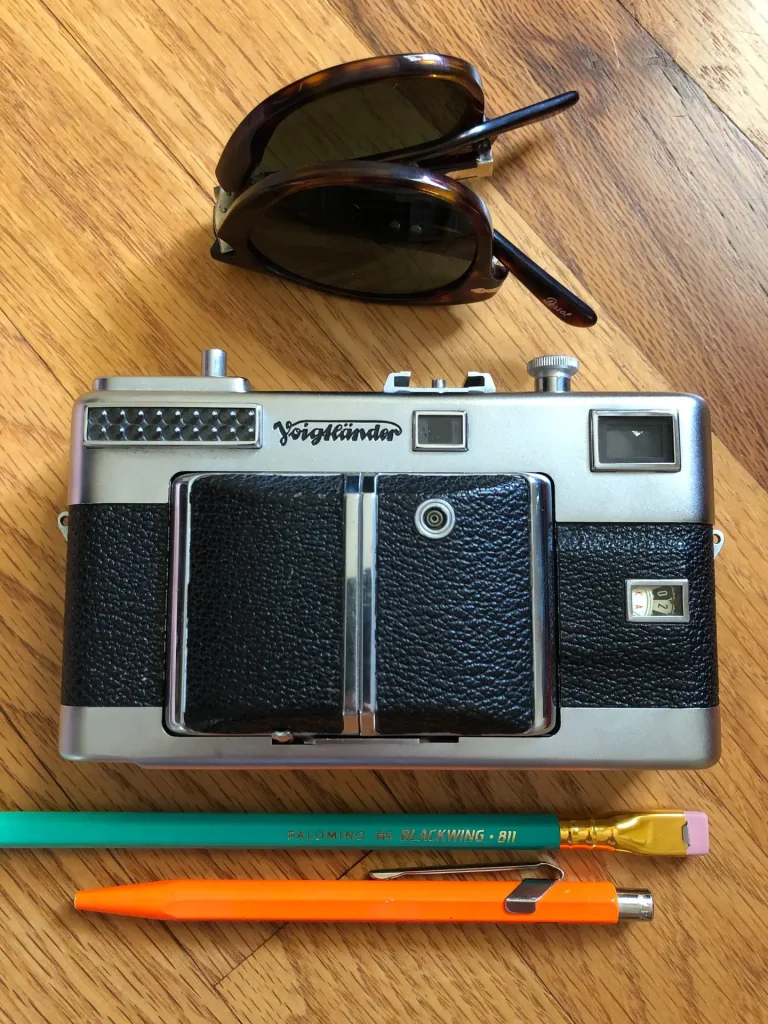
Back to the lighthouse, or combi-plunger, which is the most defining feature on a camera that could claim more than one. The combi plunger does two things in one long plunge: advance the film and cock the shutter. Take a picture…PLUNGE…Take a Picture…Plunge…
When the lens is collapsed and the barn doors are closing the plunger has one more role and needs to be pressed down to a sweet spot, nearly all the way into the body, so the doors will lock and the camera can be safely stored. This could easily fit in a jacket pocket. When it is time to open just hit the plunger down and the whole camera will spring back to life.
Light Meter
The Voigtlander Vitessa line had many variations during a decade long production run, which started in 1950. The L-Line, from which my copy hails, denotes a light meter. The L production run was from 1954-1957 and included 5 variations. Perhaps the easiest, but not definitive, way to separate is the type of light meter window. Mine is bubble-windowed, and thus most likely a type 2 or 3. There is a small serial number etched into the bottom of the lens, not sure if that is lens specific or for the entire camera. There is little information on Voigtlander serial numbers, and any I can find is very vague. Either way my serial number puts me in the year 1955, which makes sense.
The Voigtlander Vitessa meter itself is incredible. It is a selenium cell, so keep your working copy in the dark my friends. In usage it would be familiar for anyone who knows the EV system that was quite common in 1950 rangefinders. Please bear with me on this as we unpack another quirk: Engraved on the top plate in a small, yet easy to read font is a table in DIN, ASA, and WES film speeds with the letters A thru F in columns and the film rating numbers below. Next to the table there is a window that shows a match needle that corresponds to markings on a cylinder with EV numbers. The cylinder is controlled by a small rotating wheel on the back of the camera. You twist the knob until the corresponding letter for your film speed shows. Then a match needle will go to a EV number which you set on the front of the lens. The film speed and aperture are coupled based on this setting. The meter reads from EV 2 – EV 18. Adjusting the shutter or aperture is a little bit wonky, but once you are lined up on the correct settings not much needs to be done.
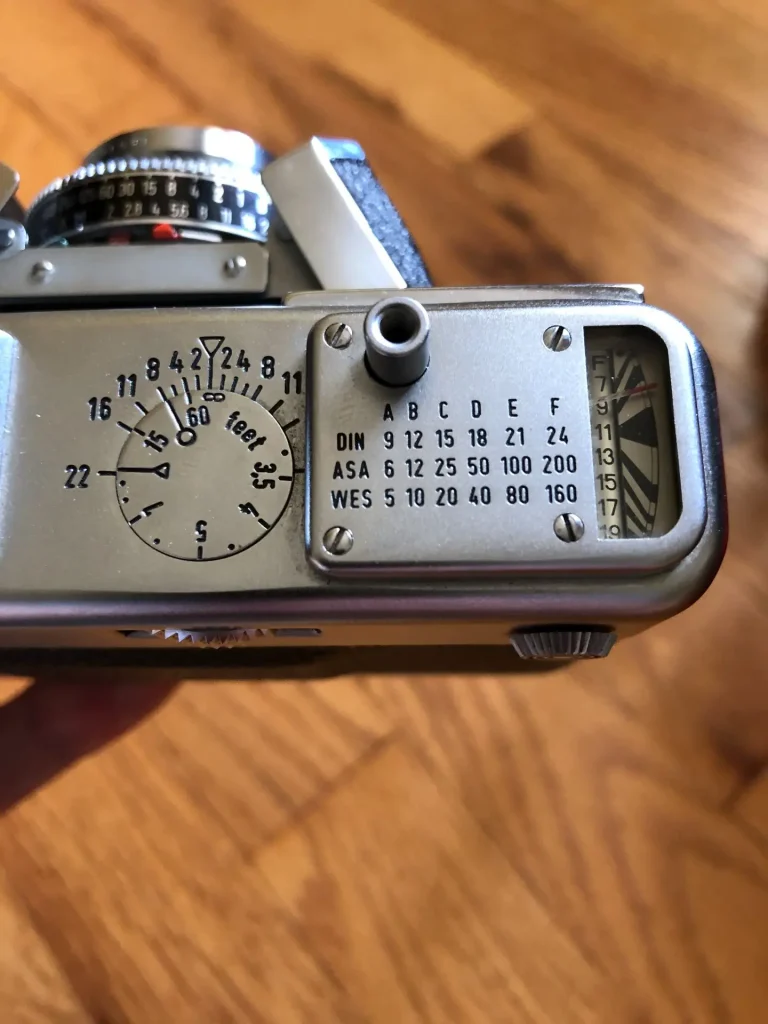
Lens
Voigtlander Vitessa lens versions vary, but mine comes with a snazzy little Voigtlander 50mm Ultron F2 which is sharp stopped down around about f4 with a smooth, creamy feel when shot wide open. The other Voigtlander Vitessa L lens options are both Color-Skopars: either f2.8 or f3.5 The lens can be unscrewed from the camera for cleaning, and it really is a marvel how small it is being that you have no helicoid (we have bellows!). I have never tried, but assume that the lenses could be interchangeable. Not everyone will get this, but the lens itself is about the size of a Famous Amos cookie (a smaller than average, mediocre but oddly satisfying chocolate chip cookie for those who don’t know)
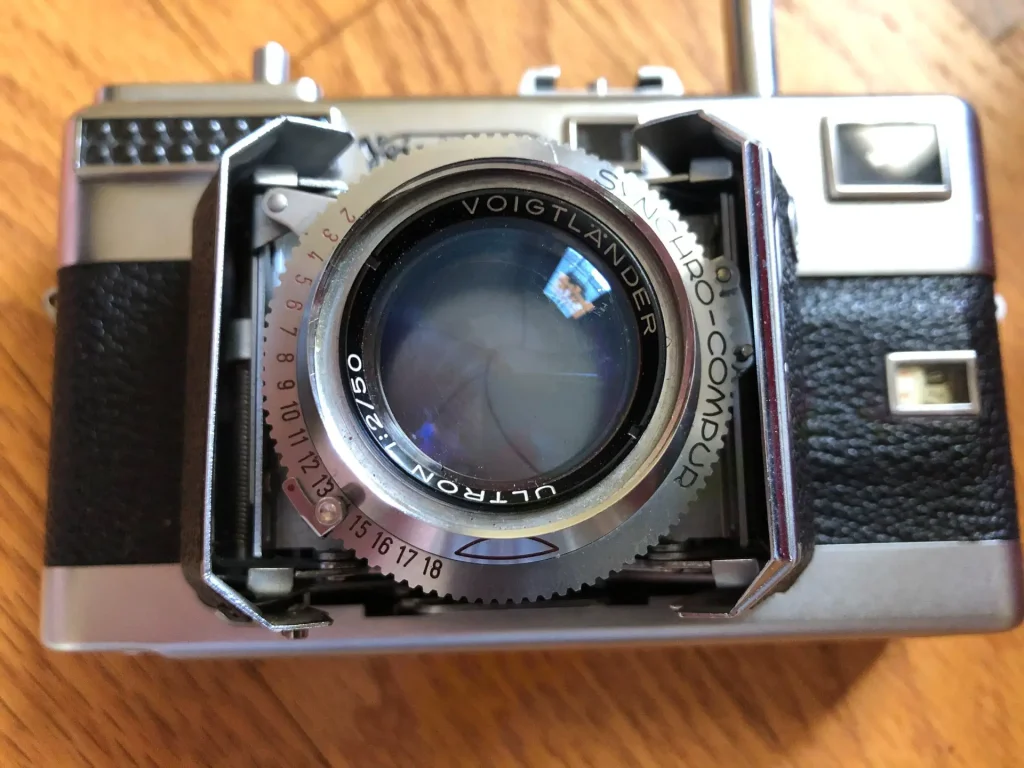
Shutter
To know them, is to love them. In the right hands, a leaf shutter can buy you another stop or two during low light situations. This is not hard and fast, but the general idea behind that thinking is that leaf shutters have a magic in them passed down from the ancient druids. Or thats what I think I read once on Reddit. In certain situations, like where there is fast movement, a leaf shutter can outperform a focal plane shutter. Somewhat of an anomaly in the 35mm rangefinder world. I know there are other leaf shutter 35mm cameras from this era, but they are still a bit rare. Why does this matter? Full flash sync at all speeds. Speaking of speed, they range from bulb/1s – 1/500th. I don’t personally shoot with a flash, but if I did the first thing I’d do would be to try it with this camera.
Focusing and Viewfinder
The Voigtlander Vitessa has so many quirks I forgot to mention, or put it in the top 10 list, that this beauty has bellows. Bellows!!! The bellows are part of the focusing system, which is, of course, also done in a neat and novel way. There is a smoothly operating thumb wheel on the back of the camera (nothing like the meat grinder on the Nikon S rangefinders). It moves the bellows of the camera in and out while also operating a finely engraved wheel on the top plate with focus distance/depth of field information. It is precise and really easy to use. The location of the wheel is in a perfect spot for a quick visual confirmation without having to move the camera too far from your eye.
This is not a particularly bright viewfinder. No frame lines either. Voigtlander still was able to design a masking system to adjust for parallax.
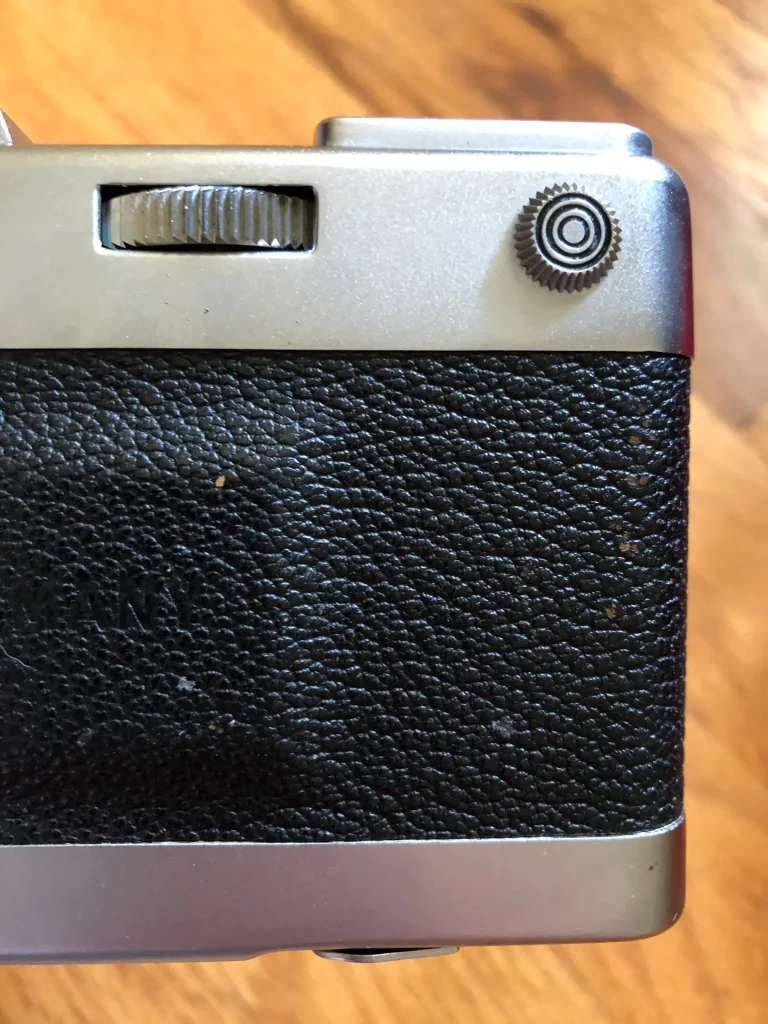
Removing the Bottom/Back/Front
I have always loved the Voigtlander Vitessa film counter window which is on the front of the camera and can’t be adjusted unless you have the back removed. The whole back, which has small parts that wrap around the front, slides off. Mine fits snug. Very snug. This was noted in the instruction manual as it mentions to move the body lock switch or film rewind crank “to and fro” to help slide the back onto the camera. It can actually take some cajoling to get off and on, which has proven to be most difficult when loading fresh film. The body lock switch itself is so precise and smooth I often have a hard time knowing if I have attached the back to the body in a proper manner.
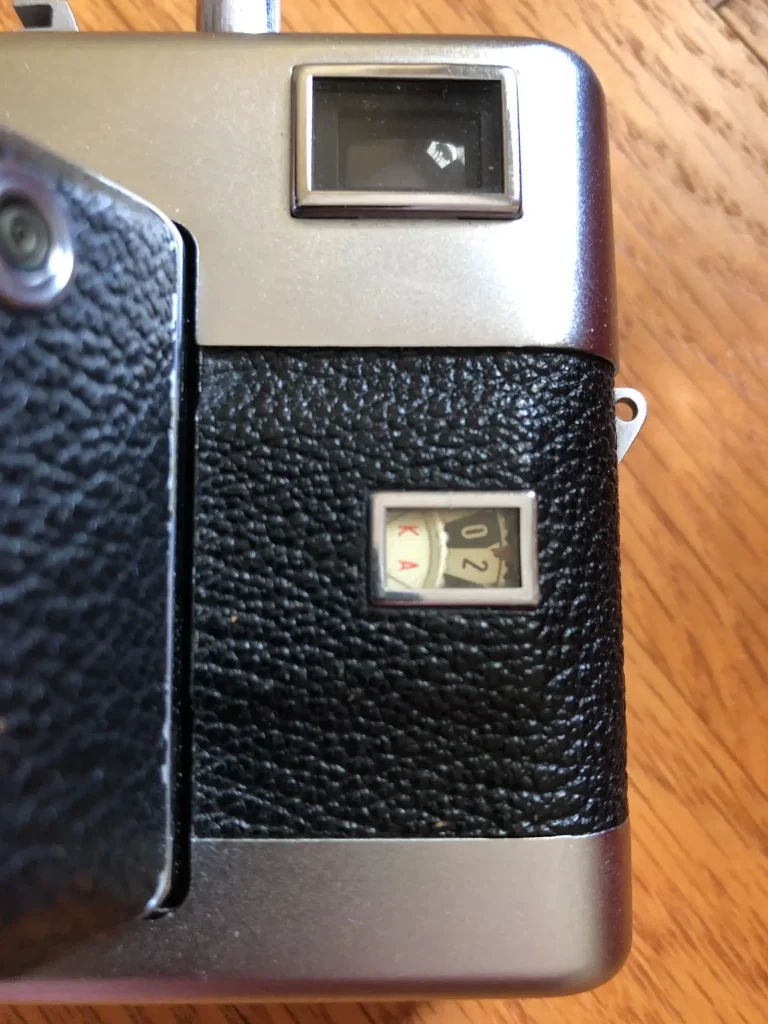
Finish/Build Quality
I’ve owned many cameras from this era (including some of the tops of the tops (nikon S3 and Leica M3 for instance)) so I don’t say this lightly: no camera I have come across has as smooth of a finish as the Voigtlander Vitessa. Almost satiny, with unbelievably smooth rounded corners that are a joy to behold. This must vary from copy to copy but mine seems impervious to the bright line scratches and smudges that plague most finishes from this era. Good on you, Voigtlander. It feels solid in the hand. Imagine the Olympus XA2 made of solid brass. That dense kind of heaviness. It is pocketable, but be sure that this paired with a windbreaker or light jacket will make you look like the Mayor of Sagville. It holds up quite well in my winter coat.
Not Tipsy
One other neat feature that I never even knew until I pulled up the instruction manual in order to write this review: When the lens is extended and you set the Voigtlander Vitessa on a flat surface it tends to tip to the front, that I knew. What I didn’t know was Voigtlander wasn’t about to let this happen. So guess what they did? They did something clever. The film rewind crank can also fold out just slightly to the front of the camera giving enough stability to act as a small stand for the camera, keeping it level and steady for when you left the tripod at home,
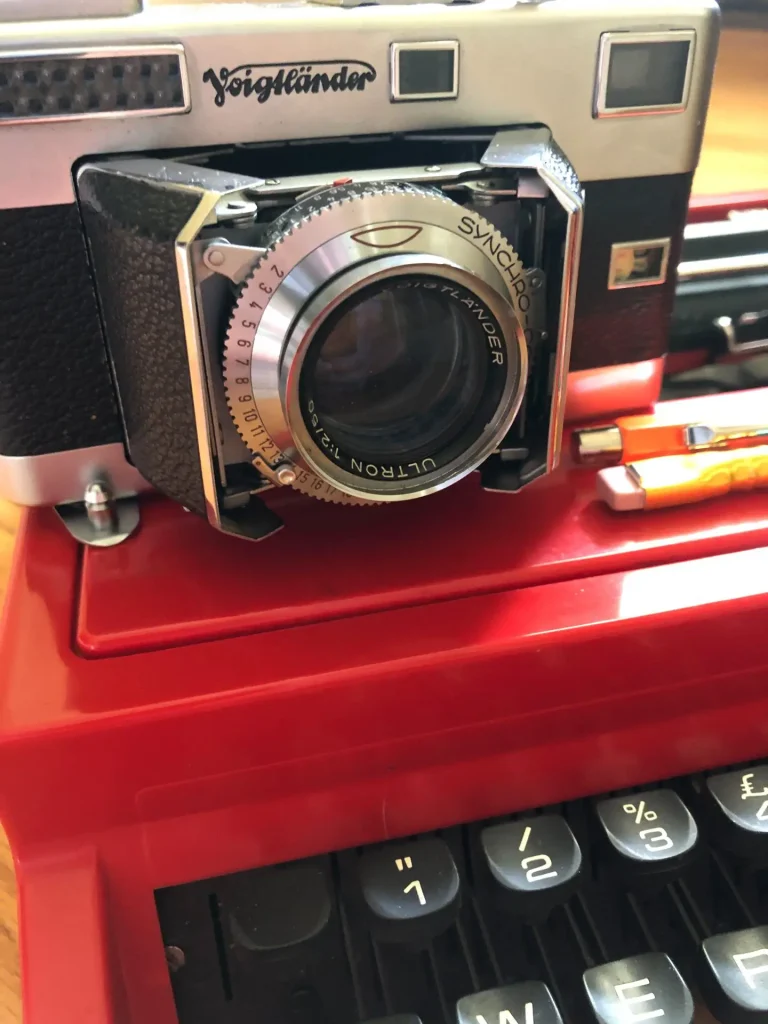
In Practice
The Voigtlander Vitessa might have a better finish than a Leica, but a Leica it is not. The combi-plunger in practical use is as simple as a film advance lever. The viewfinder is not super bright, and there are no frame lines. But the rangefinder patch is bright and works quite well. The parallax correction works, but isn’t as accurate as I wish which has resulted in a few mis-framed a few shots, I do believe with more use that issue wouldn’t be as big of deal as familiarity with the camera grows. User beware: It is hard to walk by people with this one. Any one with even a passing knowledge of cameras will be intrigued by the plunger sticking out of this camera and likely to ask a question or two about the strange object in your hand.
Sample Images
All shot on Ilford Hp5 and developed at home with d-76.
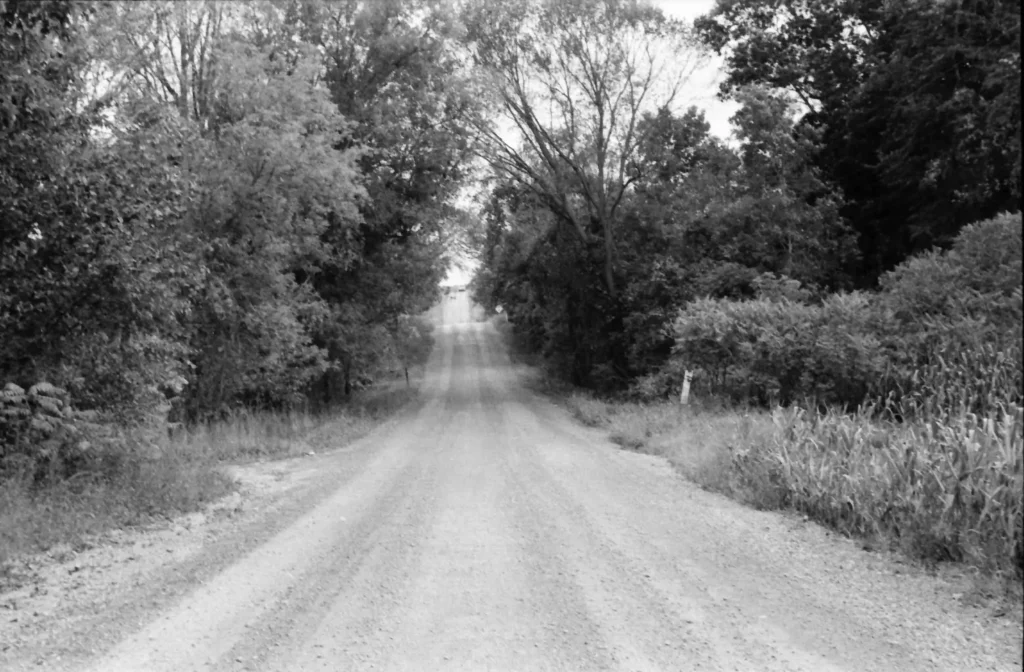
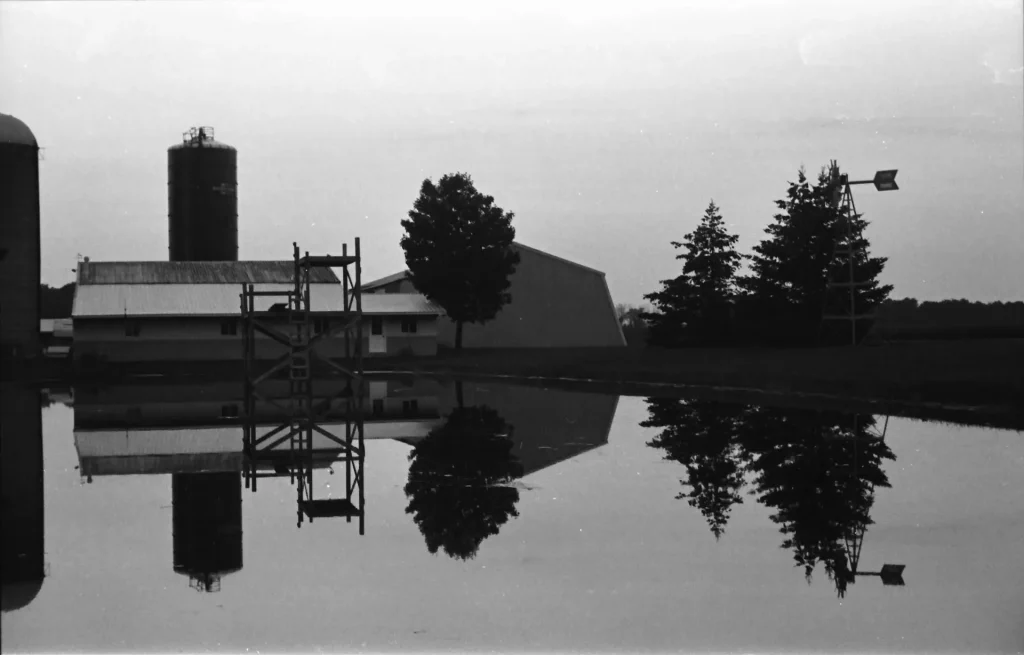
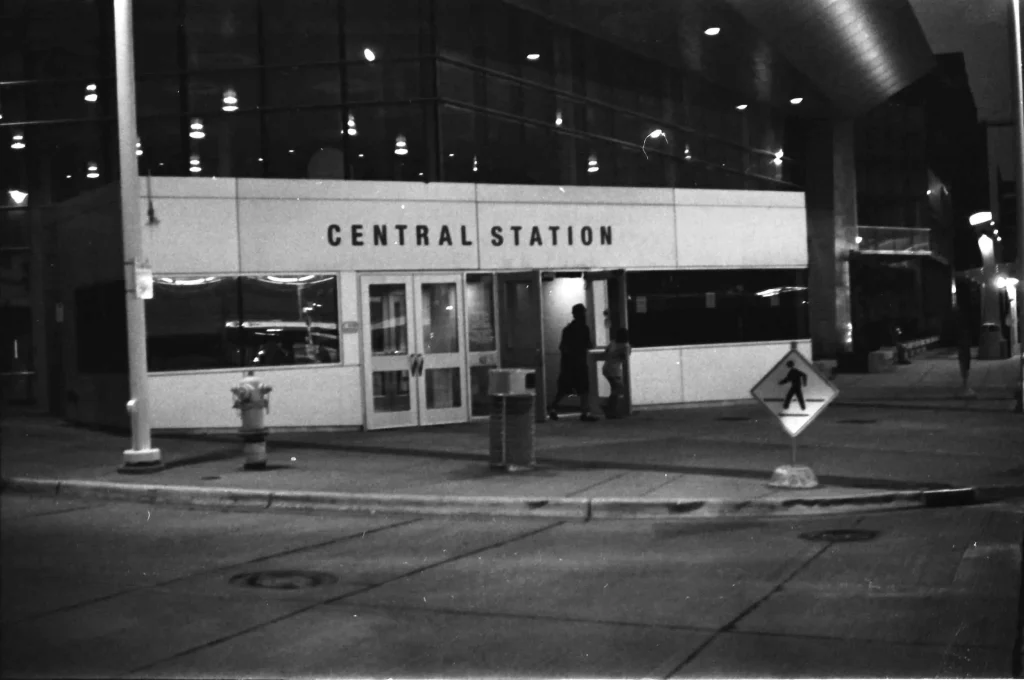
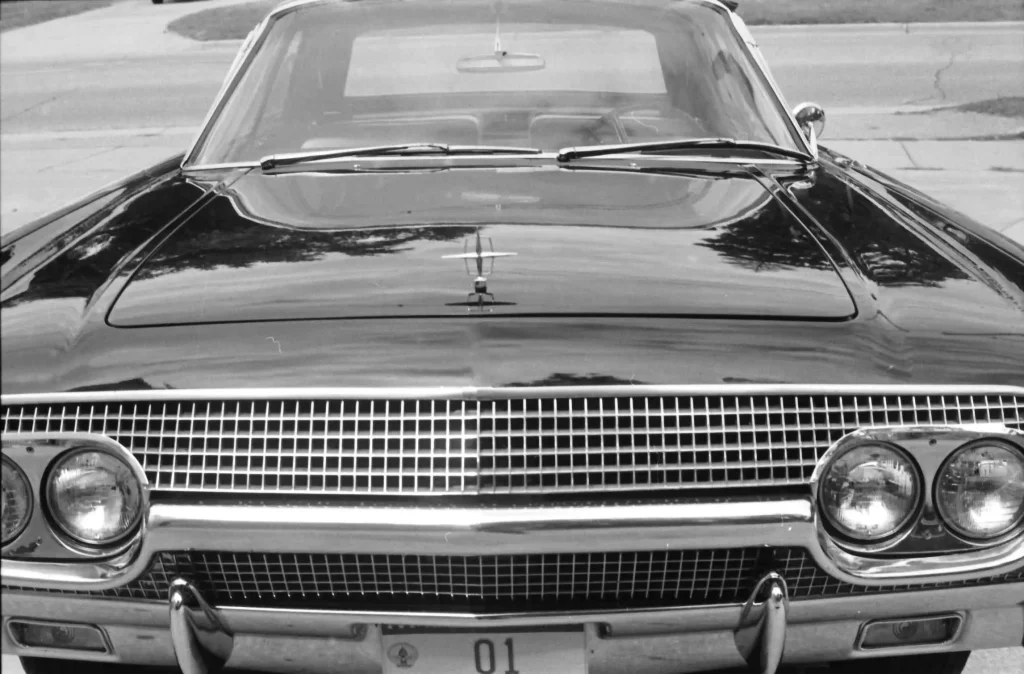
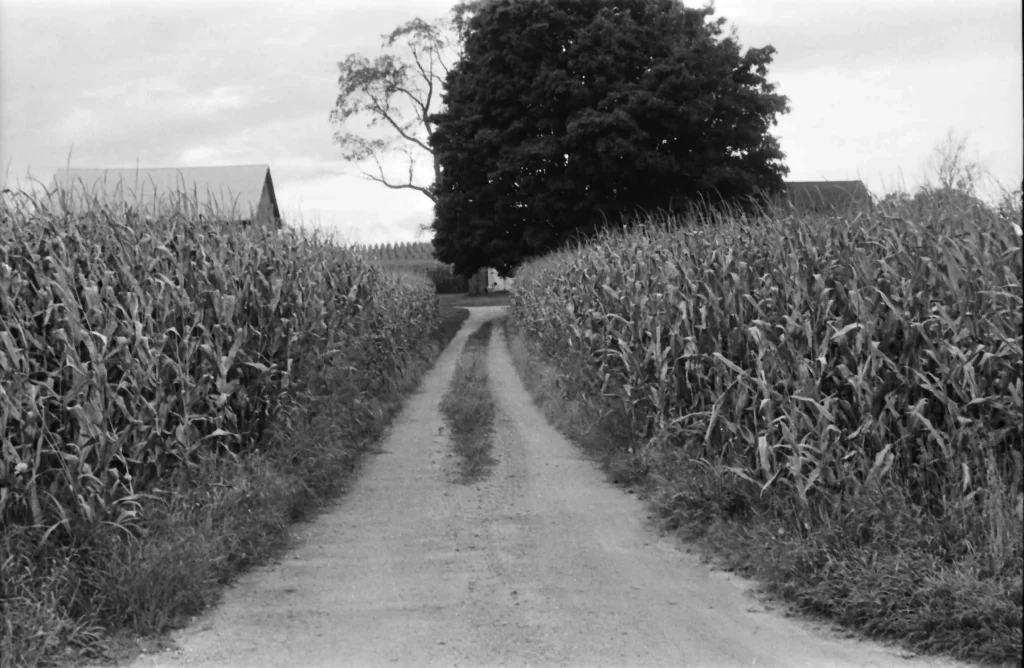
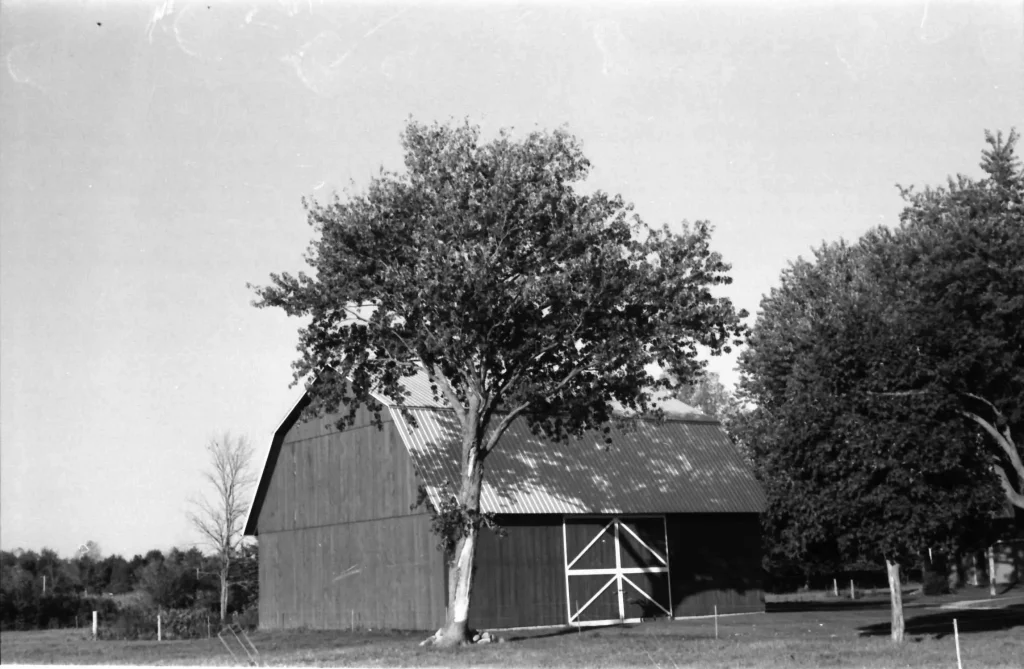
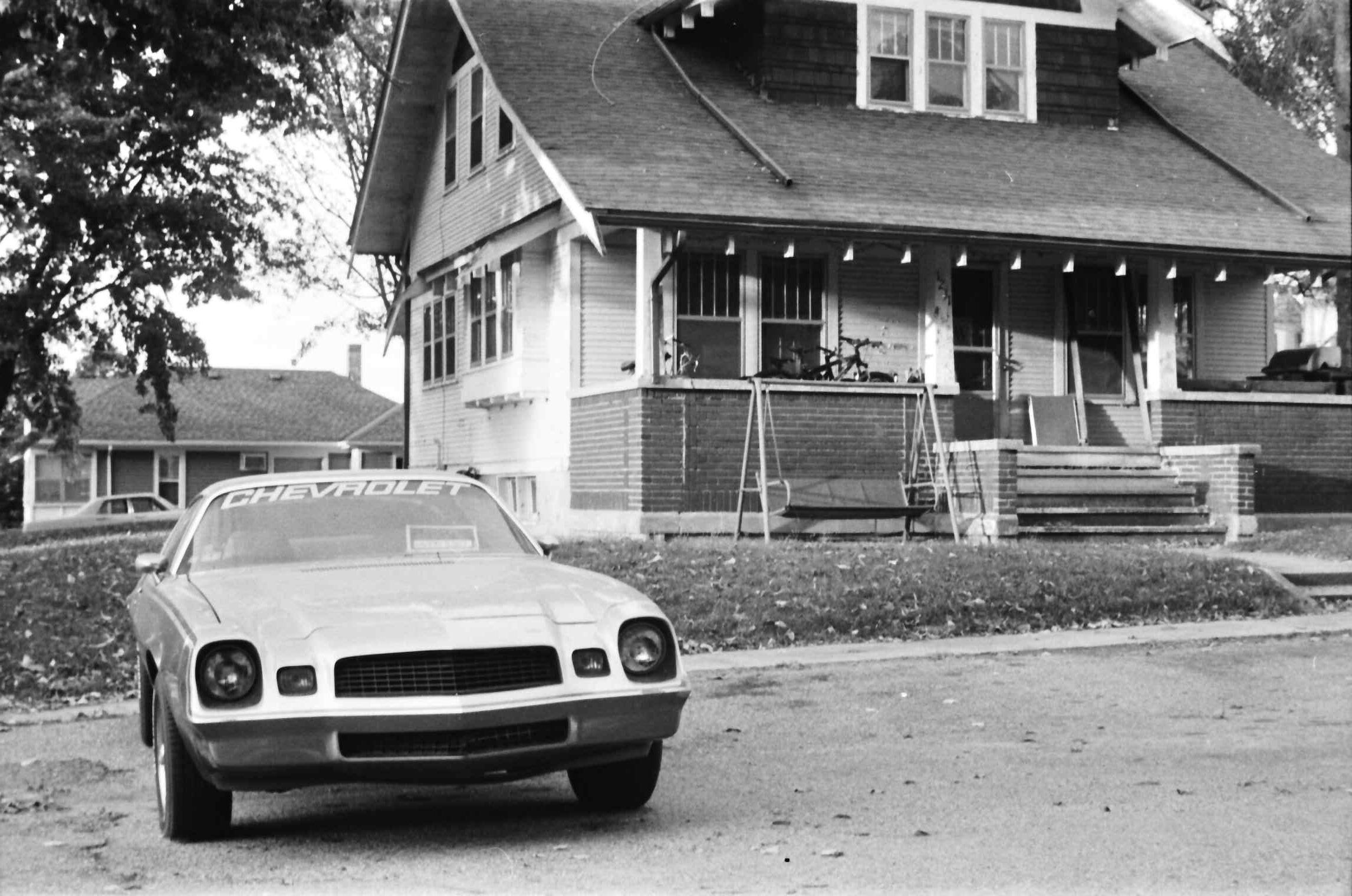
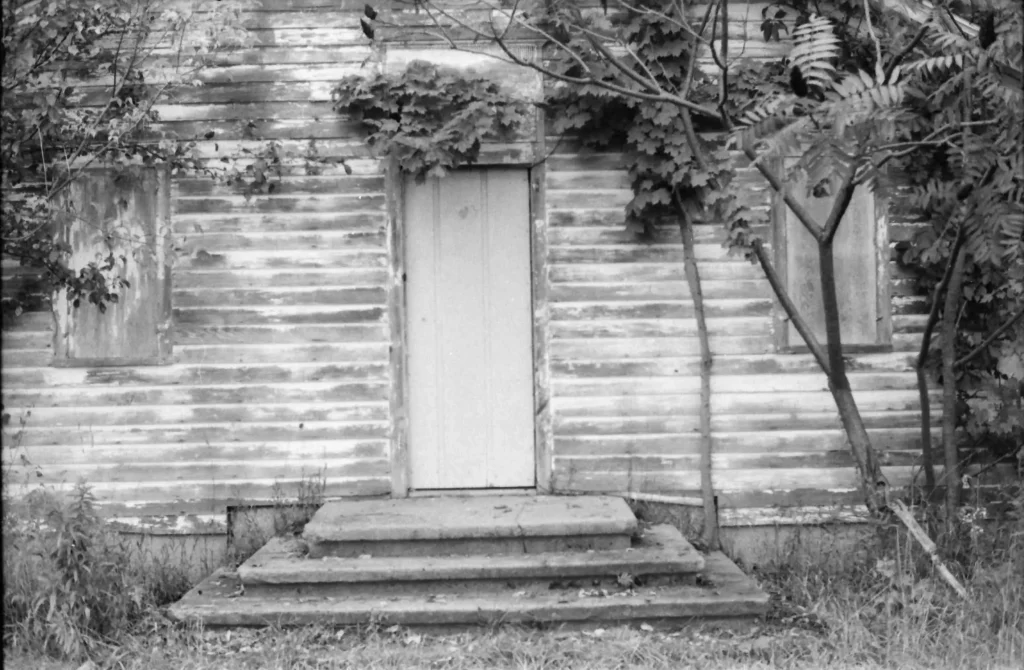
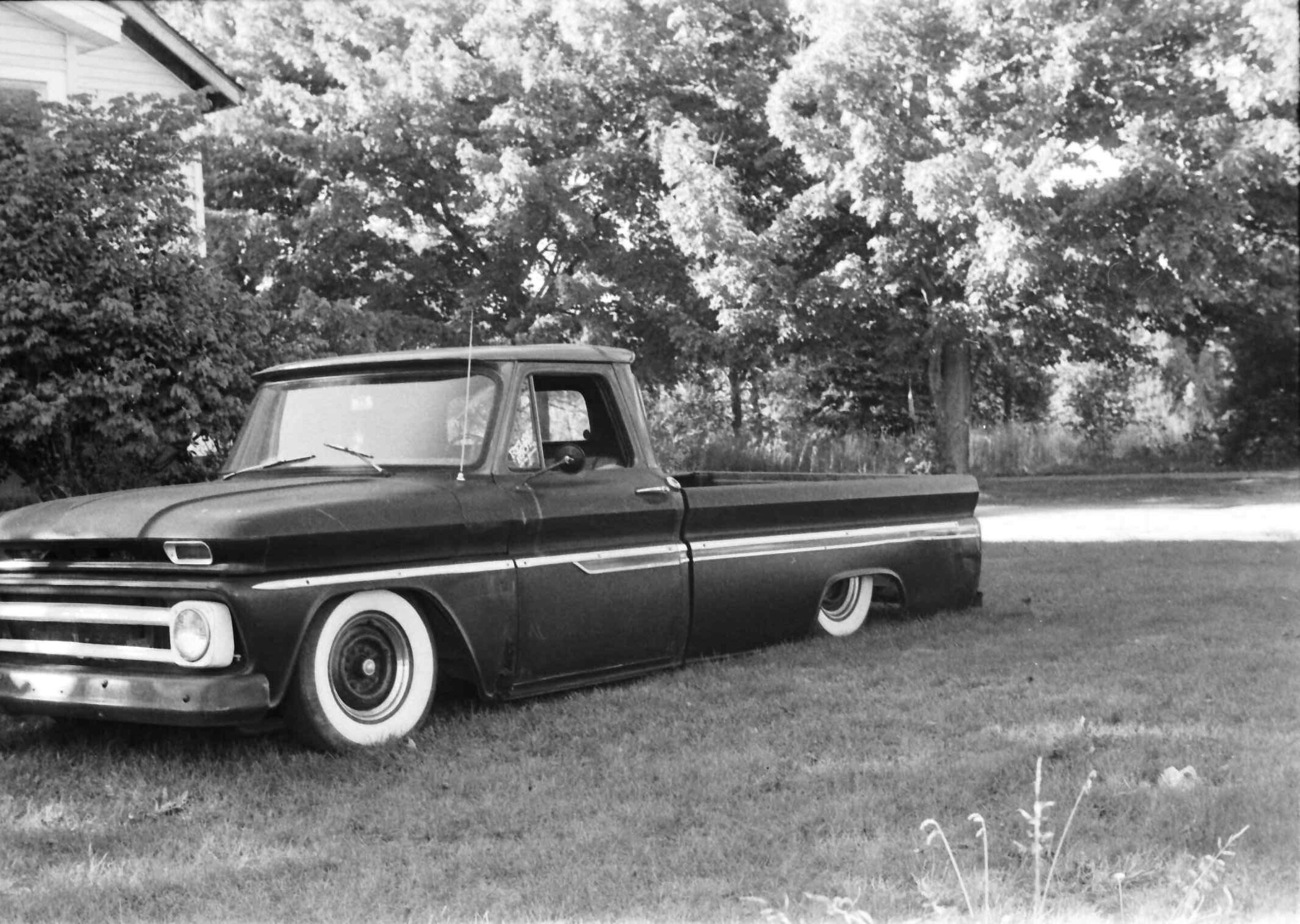
Thanks for your time!
you can find me on instagram: @stevekars
Share this post:
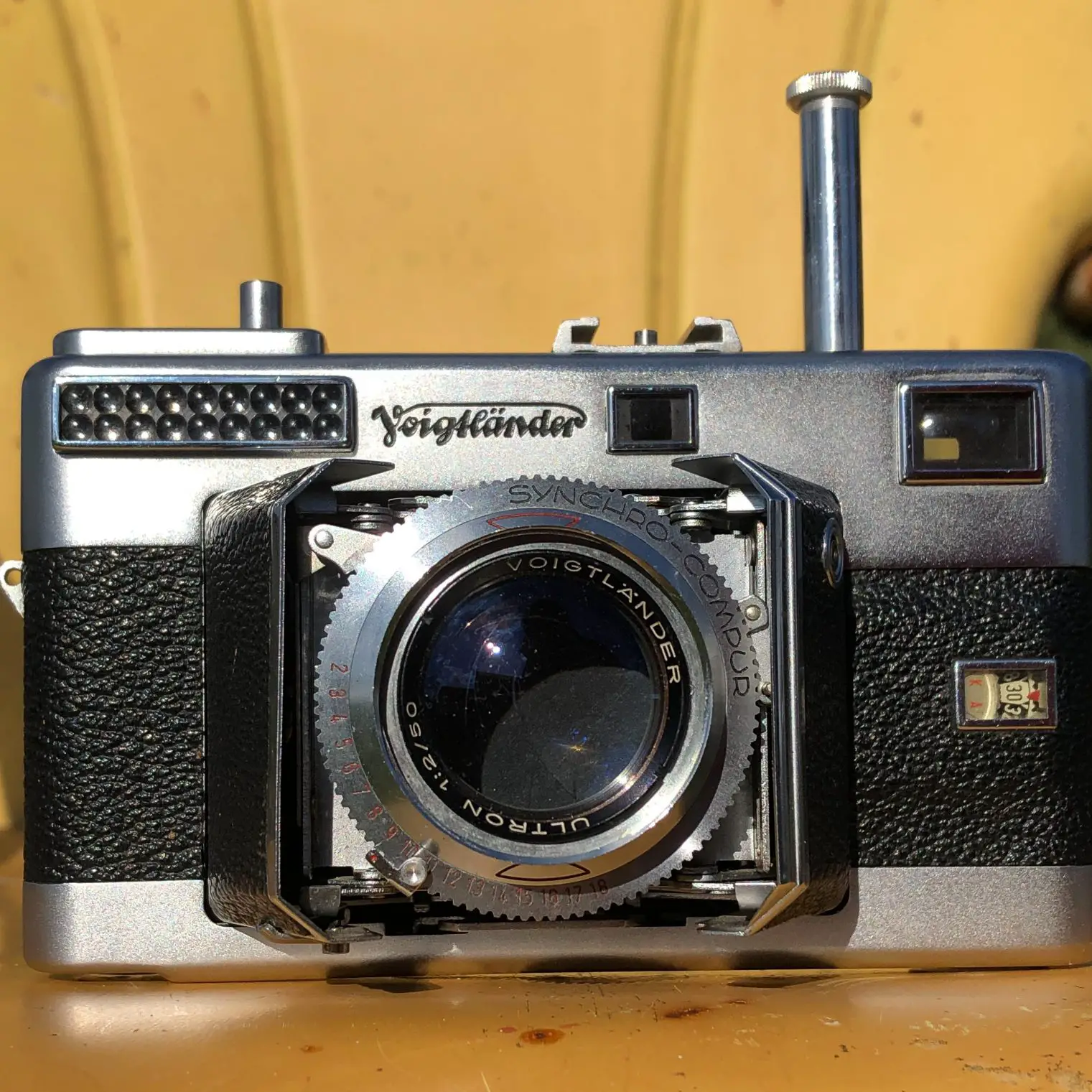








Comments
Terry B on Voigtlander Vitessa – a (non-comprehensive) review – By Steve Karsten
Comment posted: 17/07/2020
I have the basic N version, no meter, and with a f3.5 Color-Skopar, but minus the annoying (for me) EV linked shutter.
These cameras, as with many of Voigtlanders offerings, are weighty beasts, and simply exude quality. The matt satin finish of the body is uncannily smooth to the touch. I've no idea how Voigtlander achieved this but it does feel nice.
Personally, I'm not really a fan of the plunger style film advance as I don't have the legendary 12" hand span of Rachmaninov and find its actual operation somewhat ungainly. Set against this, though, focusing via the wheel on the camera back which aligns perfectly with my thumb is a dream.
It was never a main camera, and on the few occasions I took it out I did forget on a couple times to reset the frame counter before re-attaching the back after loading a film!
Willy Maes on Voigtlander Vitessa – a (non-comprehensive) review – By Steve Karsten
Comment posted: 18/07/2020
Nigel H on Voigtlander Vitessa – a (non-comprehensive) review – By Steve Karsten
Comment posted: 19/07/2020
Russell Young F.R.P.S. on Voigtlander Vitessa – a (non-comprehensive) review – By Steve Karsten
Comment posted: 20/07/2020
The Vitessa is very ergonomic in my medium-sized male hands. and when closed, slides in and out of a pocket smoothly.
The EV system is the only negative for me, otherwise, its as close to flawless as any rangefinder I have used.
Great review of a great camera and thanks for pointing out the rewind lever as a foot - had missed that!
Serhiy on Voigtlander Vitessa – a (non-comprehensive) review – By Steve Karsten
Comment posted: 20/08/2020
But... "So guess what they did? They did something clever. The film rewind crank can also fold out just slightly to the front of the camera giving enough stability to act as a small stand for the camera, keeping it level and steady for when you left the tripod at home,"
I don't know how much time you've spent with your camera, but there is a flipping leg on a right barn door, to make camera stand on a flat surface.
Comment posted: 20/08/2020
Comment posted: 20/08/2020
phong nguyen on Voigtlander Vitessa – a (non-comprehensive) review – By Steve Karsten
Comment posted: 31/01/2021
I had a Voigtlander Vitessa T and have got many nice pictures from this camera. However, when I open the back of the camera I see that it has not had the curtain like other camera. Is it the design of the camera or my camera has some problem ? Please advise and thank you in advance.
Comment posted: 31/01/2021
phong nguyen on Voigtlander Vitessa – a (non-comprehensive) review – By Steve Karsten
Comment posted: 01/02/2021
Comment posted: 01/02/2021
Alex Vye on Voigtlander Vitessa – a (non-comprehensive) review – By Steve Karsten
Comment posted: 01/02/2021
William on Voigtlander Vitessa – a (non-comprehensive) review – By Steve Karsten
Comment posted: 26/04/2021
Encouraged me to drag out my dad's Vitessa L.
Tested the shutter speeds and loaded a roll of Kodak Ektar.
Also have a Vitessa T but not sure of the accuracy of its shutter speeds.
Unlike others' comments, I really like the EV system.
It works well on my Olympus 35 SP.
I even use my Sekonic in a mode that displays EV in addition to aperture and shutter speed.
Cheers & thanks :) .
Paul on Voigtlander Vitessa – a (non-comprehensive) review – By Steve Karsten
Comment posted: 07/10/2022
Comment posted: 07/10/2022